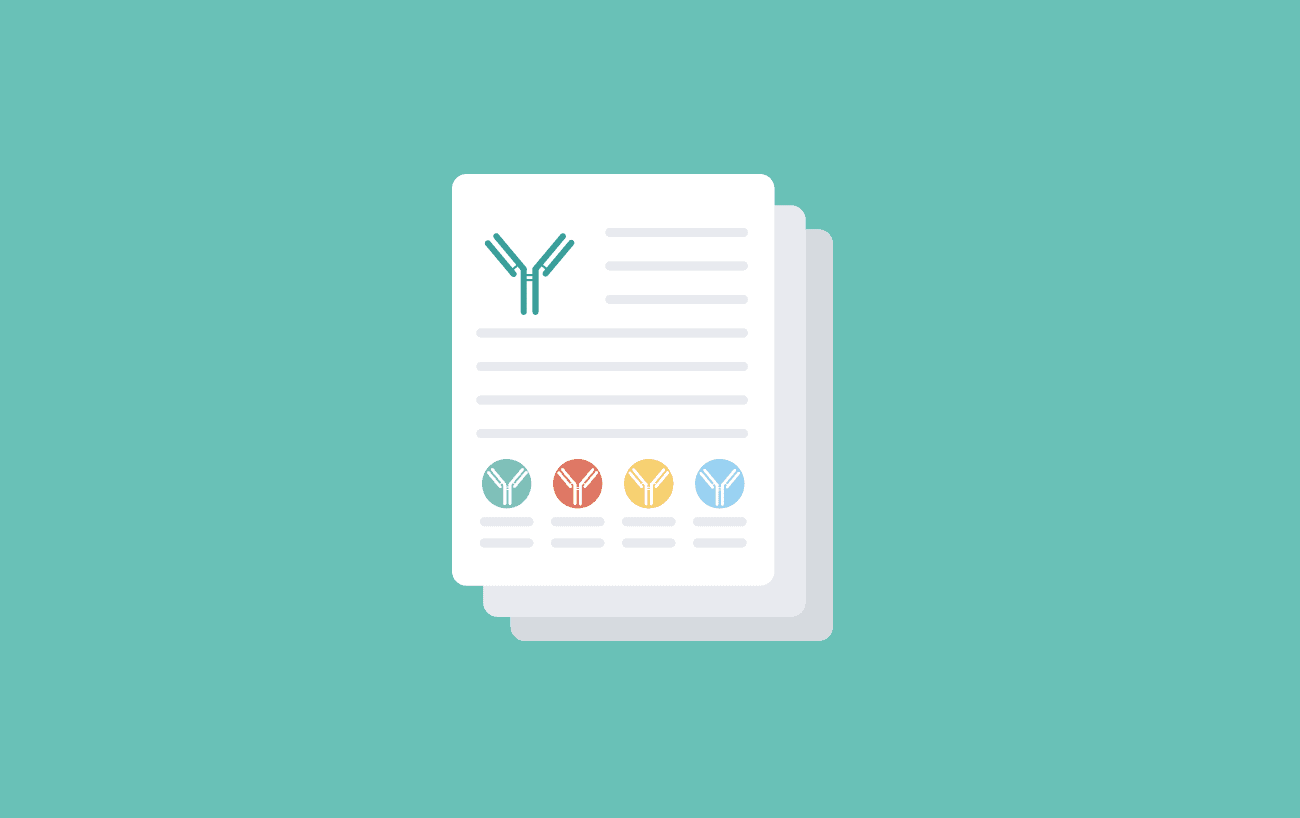Antibodies continue to be a big business. The global market for research reagents reached $2.8 billion in 2017 and the primary research antibodies global market is currently worth $945 million. However, within the scientific community there have been growing concerns regarding the quality of some commercially available antibodies. For instance, problems reproducing key experiments have been attributed to a number of factors, including antibody batch-to-batch variability and genetic drift of antibody-producing hybridomas.
Traditional methods of antibody generation and manufacture
Antibodies are most commonly generated in vivo by two main methods:
Polyclonal antibodies
Polyclonal antibodies are produced by inoculation of an animal with an antigen and adjuvant in order to elicit an immune response. Rabbits are commonly used but goats, sheep, mice and a number of other species are also suitable. The resulting polyclonal antiserum, consisting of a mixture of immunoglobulins, is collected by bleeding the animal. Once generated the polyclonal antibody is only available in finite amounts, and will eventually run out.
Monoclonal antibodies
Monoclonal antibodies are also produced by inoculation of an animal, usually mice or rats. Immune serum is collected to check for a response and then the animal spleen is harvested for the antibody-producing B-lymphocytes. These B-cells are fused with cells from an immortal myeloma cell line to yield antibody-producing hybridomas. Hybridomas producing a single antibody clone are cultured in vitro and the best performing selected by assay against the target antigen of the secreted antibody (1).
Once generated, monoclonal antibodies are manufactured either by in vitro tissue culture of the hybridoma; the hybridoma is grown in conditions to maximise secreted antibody yield. Or by in vivo injection into the peritoneal cavity of a mouse or rat; highly concentrated antibody is produced in the ascitic fluid as the hybridoma multiplies. The expressed antibody is then harvested from the tissue culture medium or abdominal cavity fluid and purified if required.
Issues
The reproducibility issues associated with these methods have gained momentum with discussion in numerous publications, most notably in the leading scientific journal Nature (2,3). Bradbury and Pluckthun along with 110 co-signatories voiced concerns regarding the reproducibility of research performed using antibodies. They reported problems with poorly characterised antibodies and batch-to batch variability. The solution put forward was to utilize recombinant antibody technology. Key hybridomas can be sequenced and the sequences used to manufacture recombinant versions of essential antibodies.
Recombinant antibody generation
Phage display technology was first developed in the 1980s as a method to display recombinant proteins, and then later antibodies, on the surface of a virus (bacteriophage). The displayed antibody could then be screened for its interaction with a protein of interest (4,5). Briefly, phage display employs a library of recombinant gene fragments encoding antibody heavy and light chains. When cloned into special bacteriophage vectors (phagemids) and used to infect E. coli; the antibody chains are expressed and displayed on the bacteriophage surface. This enables an antibody library consisting of combined heavy and light chain fragments to be screened against an immobilized antigen of interest.
Phage expressing antibody specific for the target will stay bound to the immobilized protein. Bound phage can then be eluted and re-infected into E.coli to enrich the population of antigen binding antibody. Successive rounds of screening (panning) further enrich the phage, containing DNA encoding the binding antibody. Genes encoding antibody with the highest affinity and selectivity for the target can be subcloned from the phage, sequenced and used for large-scale manufacture of recombinant antibody in an expression system of choice. Since phage display was first developed, many other cell surface display systems including yeast, insect and mammalian display are now in use.
More recent technology to generate recombinant antibodies utilizes B-cell sequencing. Blood samples taken from patients suffering from viral infections or autoimmune disease can provide a source of antibody producing B-cells. The B-cells are single cell sorted, immortalized with Epstein-Barr virus (EBV), cultured and after two weeks the secreted antibody screened for reactivity against viral antigen. Positive cells are expanded and the secreted antibody sequenced. This process allows recombinant antibodies to be swiftly generated against deadly viruses such as Ebola virus, and other pathogens causing public health issues such as Zika virus (6).
Commercially available recombinant antibodies
Leaders in the antibody market, alongside their ranges of standard monoclonal and polyclonal antibodies, now offer a variety of recombinant antibodies as part of their portfolio. In addition to modifications on the phage display technique described previously, companies also employ recombinant DNA technology to manufacture antibody in bacterial, yeast and mammalian host cell expression systems.
A few examples are described below.
Bio-Rad’s custom antibody generation service, known as HuCAL (Human Combinatorial Antibody Libraries), generates fully human recombinant antibodies against a customer’s target of interest. The HuCAL Platinum library consists of 45 billion antibodies and covers 95% of the human structural immune repertoire. The library is screened by a proprietary form of phage display, CysDisplay against the customer’s target antigen. After selection and enrichment of phage by panning, large scale production of specific Fab antibodies is performed in E.coli.
Absolute Antibody’s HEXpress service manufactures fully recombinant antibody from an antibody sequence or existing hybridoma. Transient expression of the cloned antibody in mammalian HEK293 cells enables rapid and high yield recombinant antibody production. Their hybridoma sequencing service allows the sequence of valuable antibodies to be preserved and enables future recombinant production and engineering if desired. Antibody engineering is further discussed in the next section, with Absolute Antibody’s Antibody Engineering Service used as an example (Fig. 2). Absolute Antibody’s complete antibody catalogue consists of only recombinant antibodies.
Thermo Fisher Scientific’s ABfinity™ system generates its range of rabbit recombinant antibodies by immunizing the target of interest into rabbits. The resulting B-cell population is isolated and screened for expression of antibody specific for the target. Immunogen specific antibody is then cloned into expression vectors before further screening takes place. The best candidates are then subcloned into mammalian expression vectors and used for large scale mammalian expression of recombinant antibody.
GenScript provide a variety of recombinant antibody expression services, for custom manufacture of antibody from its DNA sequence. Antibodies are expressed in stable or transient mammalian expression systems, in a range of quantities and to customer specifications.
Miltenyi Biotec’s REAfinity™ range of recombinant antibodies feature a mutated Fc region to reduce background staining, and are a single isotype (IgG1) for simplicity of assay design.
Advantages of recombinant antibodies
Recombinant antibodies offer many advantages over traditional methods of antibody manufacture. There are some excellent antibody-producing hybridomas specific for key targets; but they can die, deteriorate or go missing in storage. With recombinant antibodies the DNA and protein sequence is known, so a key antibody cannot be lost, as there will always be the option to remake the expression vector if needed. Hybridomas can also become contaminated with pathogens, other hybridomas or not be clonal at all. Routine manufacture in tissue culture is animal-free unlike polyclonal generation or manufacture of monoclonal antibody in ascites.
Phage display based methods enable the production of antibodies against toxic immunogens, which can be problematic in live animals. The recombinant nature of the antibody production allows antibody engineering to meet specific needs. Such as a change of species, isotype and alternative formats such as Fab, F(ab’)2 and addition of epitope tags (Fig. 2), thus opening up new avenues of investigation to researchers. This level of flexibility and convenience, which was previously unavailable using traditional methods, should reinvigorate the antibody market.
Summary
Antibody production based on hybridoma technologies is well established within the industry, and likely to continue making a substantial contribution to the antibody marketplace. The use of ascites as a method of monoclonal antibody manufacture is declining, with many regions in Europe discouraging its use due to animal welfare concerns. It has persisted despite some resistance, due to its high yields and ability to produce antibody where other in vitro methods have failed.
Polyclonal antibodies, although convenient to make, rely on in vivo methods which will always be less favourable compared to non-animal methods. The resulting polyclonal mixture of antibody clones, although sensitive and useful for certain applications, lacks the precision many modern laboratory techniques demand. Polyclonal antibody will eventually run out once the animal serum is exhausted. Interestingly, using a combination of NextGen sequencing and mass spectrometry (LS-MS/MS). It is now possible to determine the antigen-specific polyclonal antibody response from animal serum (7).
Use of recombinant technology is expected to become more widespread due to increased availability and the flexibility to produce engineered antibodies exactly meeting customer needs. The recombinant antibodies are of a known sequence, so in combination with the industry as a whole introducing more rigorous validation of their products, this should go some way to increase confidence in the validity of research generated using antibodies.
Contact us for more information on recommended distributors and B2B introductions.
References
1. Köhler, G. and Milstein, C. Nature 256, 495-497 (1975)
2. Bradbury, A. and Pluckthun, A. Nature 518, 27-29 (2015)
3. Baker, M. Nature 521, 274–276 (2015)
4. Smith, G. Science 228, 1315-7 (1985)
5. McCafferty, J. et al. Nature 348, 552-554 (1990)
6. Stettler, K. et al. Science 353, 823-826 (2016)
7. Wine, Y. et al. Proc Natl Acad Sci 110, 2993–2998 (2013)





